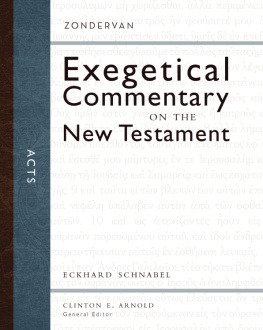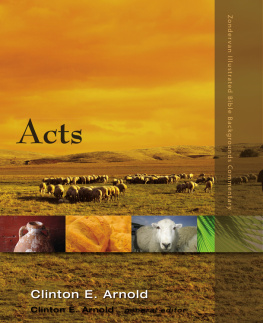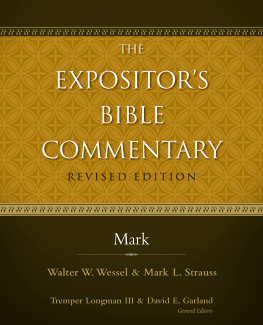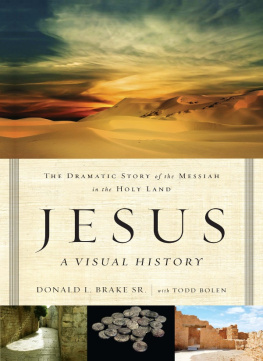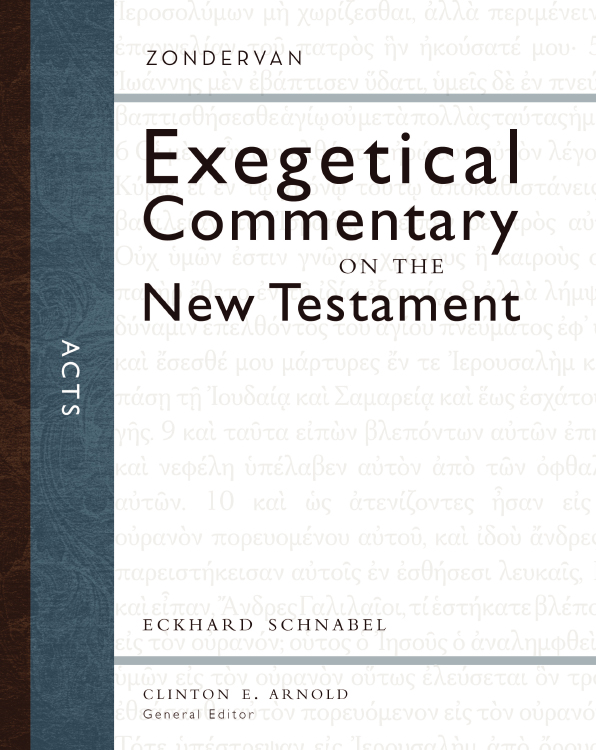
Zondervan Exegetical Commentary Series: New Testament
Editorial Board
General Editor
Clinton E. Arnold
Talbot School of Theology
Associate Editors
George H. Guthrie
Union University
William D. Mounce
Washougal, Washington
Thomas R. Schreiner
Southern Baptist Theological Seminary
Mark L. Strauss
Bethel Seminary, San Diego
Zondervan Editors
Editorial Advisor: David Frees
Development Editor: Verlyn D. Verbrugge
Consulting Editors
Richard Bewes, Rector, All Souls Church, Langham Place, London, UK
Craig Blomberg, Professor of New Testament, Denver Seminary
Ajith Fernando, National Director of Youth for Christ, Sri Lanka
David E. Garland, Professor of New Testament, George W. Truett Theological Seminary
Paul Gardner, Archdeacon of Exeter, Exeter, UK
Carolyn Custis James, Author and Speaker, Orlando, FL
Karen Jobes, Gerald F. Hawthorne Professor of New Testament Greek & Exegesis, Wheaton College and Graduate School
David W. Pao, Professor of New Testament and Chair of the New Testament Department, Trinity Evangelical Divinity School
Frank Thielman, Presbyterian Professor of Divinity, Beeson Divinity School
Tite Tienou, Academic Dean and Professor of Theology of Mission, Trinity Evangelical Divinity School
Acts
Zondervan Exegetical Commentary on the New Testament
Eckhard J. Schnabel
Clinton E. Arnold
General Editor

For
I. H. Marshall
D. A. Carson
ZONDERVAN
Acts
Copyright 2012 by Eckhard J. Schnabel
Requests for information should be addressed to:
Zondervan, Grand Rapids, Michigan 49546
ePub Edition May 2016: 978-0-310-53213-2
Library of Congress Cataloging-in-Publication Data
Schnabel, Eckhard J.
Acts / Eckhard J. Schnabel.
p. cm(Zondervan exegetical commentary on the New Testament)
Includes .
ISBN: 978-0-310-24367-0 (hardcover)
1. Bible N.T. ActsCommentaries. I. Title.
BS2625.53.S35 2012
226.6'07dc23 2012002045
All Scripture quotations from books other than Acts (which is a translation by the author), unless otherwise indicated, are taken from the Holy Bible, New International Version, NIV. Copyright 1973, 1978, 1984, 2011 by Biblica, Inc. Used by permission. All rights reserved worldwide.
Any Internet addresses (websites, blogs, etc.) and telephone numbers in this book are offered as a resource. They are not intended in any way to be or imply an endorsement by Zondervan, nor does Zondervan vouch for the content of these sites and numbers for the life of this book.
All rights reserved. No part of this publication may be reproduced, stored in a retrieval system, or transmitted in any form or by any meanselectronic, mechanical, photocopy, recording, or any otherexcept for brief quotations in printed reviews, without the prior permission of the publisher.
Cover design: Tammy Johnson
Contents
The Translation Outlines in this book have been rendered as images in the eBook edition in order to accurately display the complex formatting on various eReader devices and platforms.
Use your readers image zoom feature for the best view of these images.
This generation has been blessed with an abundance of excellent commentaries. Some are technical and do a good job of addressing issues that the critics have raised; other commentaries are long and provide extensive information about word usage and catalog nearly every opinion expressed on the various interpretive issues; still other commentaries focus on providing cultural and historical background information; and then there are those commentaries that endeavor to draw out many applicational insights.
The key question to ask is: What are you looking for in a commentary? This commentary series might be for you if
- you have taken Greek and would like a commentary that helps you apply what you have learned without assuming you are a well-trained scholar.
- you would find it useful to see a concise, one- or two-sentence statement of what the commentator thinks the main point of each passage is.
- you would like help interpreting the words of Scripture without getting bogged down in scholarly issues that seem irrelevant to the life of the church.
- you would like to see a visual representation (a graphical display) of the flow of thought in each passage.
- you would like expert guidance from solid evangelical scholars who set out to explain the meaning of the original text in the clearest way possible and to help you navigate through the main interpretive issues.
- you want to benefit from the results of the latest and best scholarly studies and historical information that help to illuminate the meaning of the text.
- you would find it useful to see a brief summary of the key theological insights that can be gleaned from each passage and some discussion of the relevance of these for Christians today.
These are just some of the features that characterize the new Zondervan Exegetical Commentary on the New Testament series. The idea for this series was refined over time by an editorial board who listened to pastors and teachers express what they wanted to see in a commentary series based on the Greek text. That board consisted of myself, George H. Guthrie, William D. Mounce, Thomas R. Schreiner, and Mark L. Strauss along with Zondervan senior editor at large Verlyn Verbrugge, and former Zondervan senior acquisitions editor Jack Kuhatschek. We also enlisted a board of consulting editors who are active pastors, ministry leaders, and seminary professors to help in the process of designing a commentary series that will be useful to the church. Zondervan senior acquisitions editor Katya Covrett has now been shepherding the process to completion.
We arrived at a design that includes seven components for the treatment of each biblical passage. What follows is a brief orientation to these primary components of the commentary.
Literary Context
In this section, you will find a concise discussion of how the passage functions in the broader literary context of the book. The commentator highlights connections with the preceding and following material in the book and makes observations on the key literary features of this text.
Main Idea
Many readers will find this to be an enormously helpful feature of this series. For each passage, the commentator carefully crafts a one- or two-sentence statement of the big idea or central thrust of the passage.
Translation and Graphical Layout
Another unique feature of this series is the presentation of each commentators translation of the Greek text in a graphical layout. The purpose of this diagram is to help the reader visualize, and thus better understand, the flow of thought within the text. The translation itself reflects the interpretive decisions made by each commentator in the Explanation section of the commentary. Here are a few insights that will help you to understand the way these are put together:
- 1. On the far left side next to the verse numbers is a series of interpretive labels that indicate the function of each clause or phrase of the biblical text. The corresponding portion of the text is on the same line to the right of the label. We have not used technical linguistic jargon for these, so they should be easily understood.
Next page
